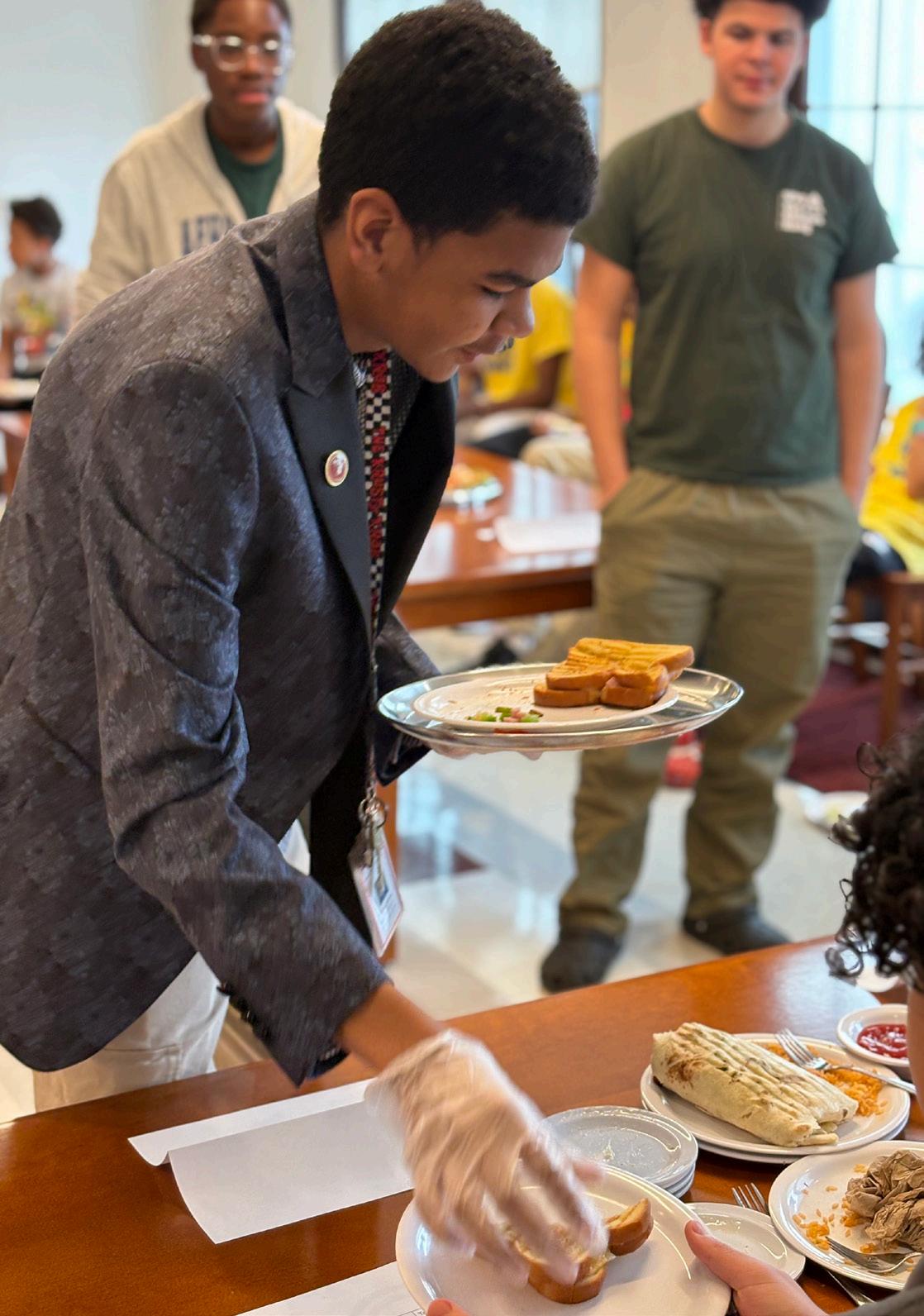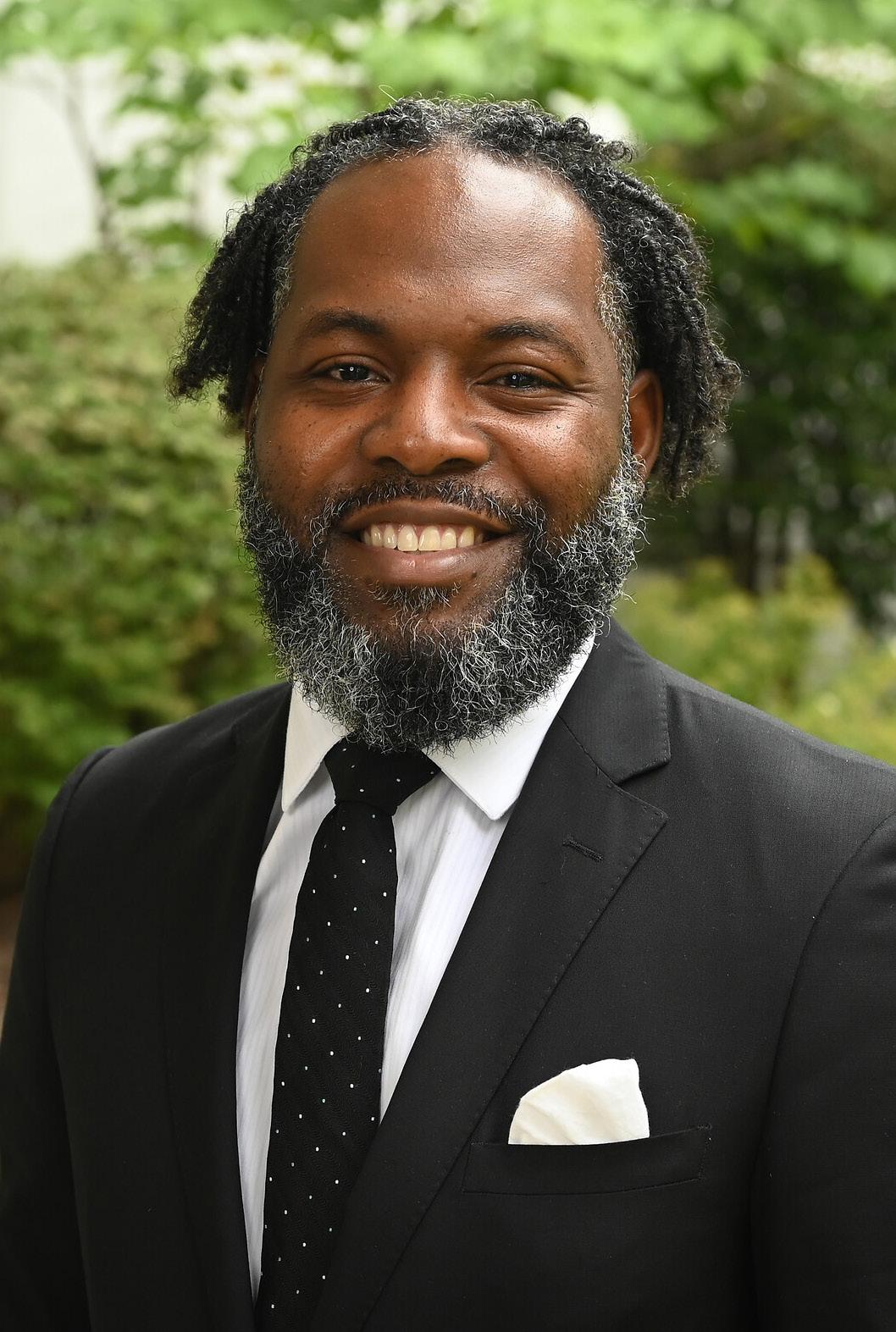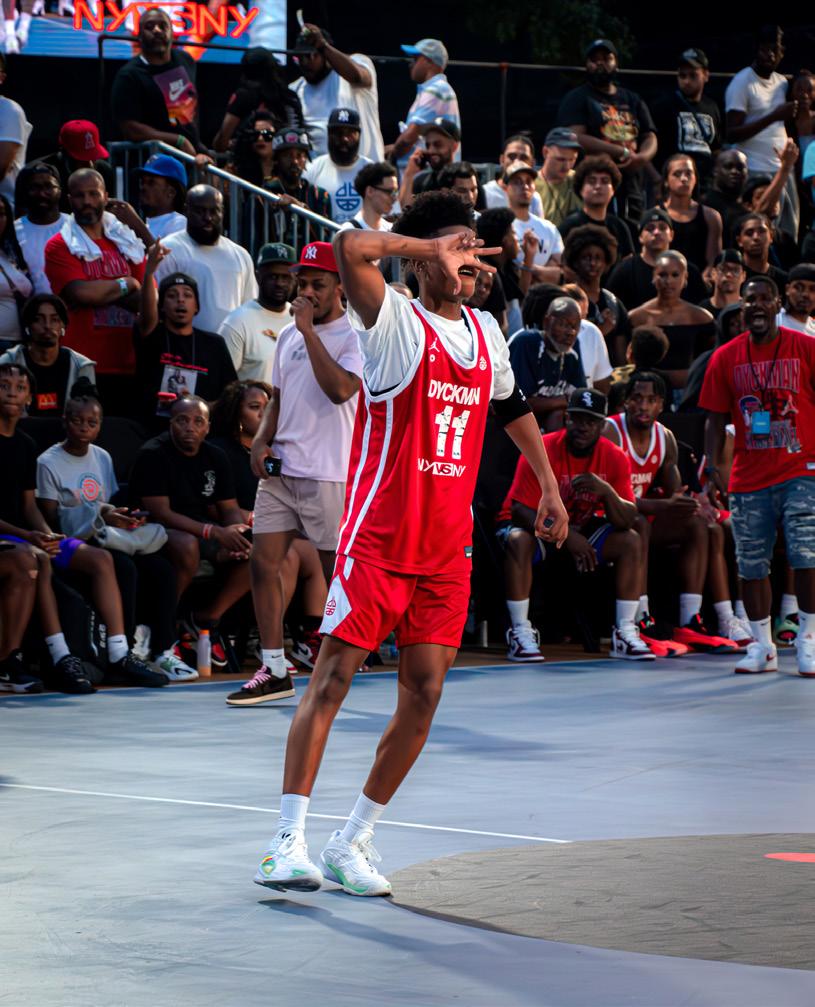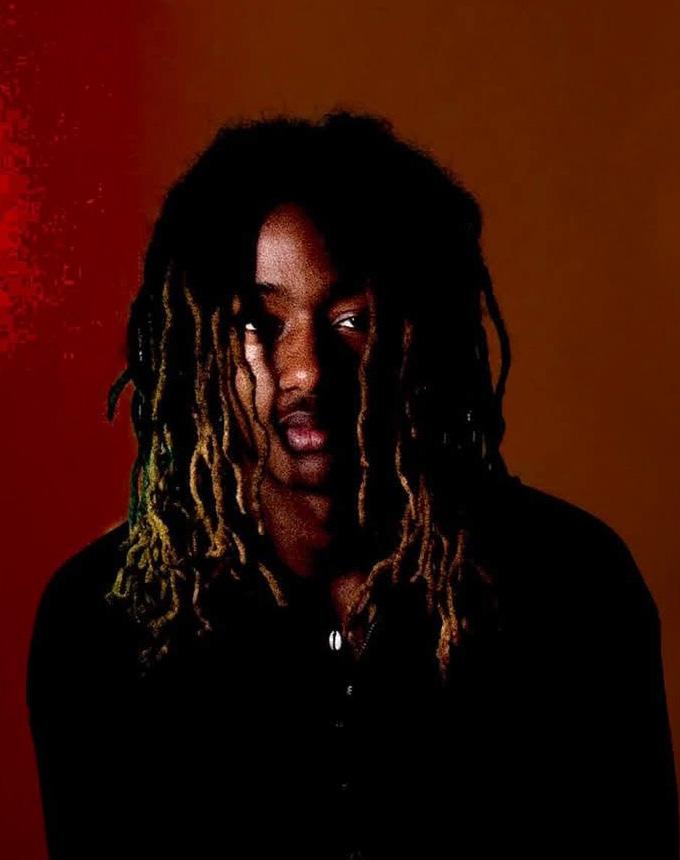GRIFFIN REVIEW

CHURCH



CHURCH

Editor In-Chief
Assistant Editor In-Chief
Interviews
Layout & Design
Nonfiction Editor
Fiction Editor
Editorial Assistant
Poetry Editor
Arts Editor
Content Editors
Faculty Advisors
Amadu Jalloh
Savion Weaver-Diaz
Caleb Fulmer, Hadee Rashid, Kordell Tate-Roberts, Joey Pinnelli, Finn Kwon
Oscar Lu, Victor Lu, Kibel Gomez
Dennis Smith
Amadu Jalloh
Josh Morgan
Eddie Echevarria
Josh Jennings
Hector Audelo-Gutierrez, Jayden
Nzekio, Aidan Brown
Mr. Fulmer, Mr. Love



This year’s Griffin Review is pleased to dedicate the magazine to Mr. Warfel, in honor of his outstanding contributions to our CFS community and to the Griffin Review Magazine.
Mr. Warfel serves as a humanities teacher, GSDA Club Advisor, Dean of Residential Life, 10th Grade Class Chair, and perhaps most proudly, the father of his dog - Grayson. Through each of these roles, he has demonstrated deep compassion for the school and unwavering care for its students.
Whether offering thoughtful guidance, sparking meaningful discussions, or showing up with encouragement and energy, Mr. Warfel has played a vital role in shaping student experiences and fostering a positive environment at CFS. His influence can be felt in the classroom, during clubs, in residential life, and in the quiet, daily moments that reveal his commitment to building an inclusive and supportive brotherhood. He has also consistently contributed thoughtful insights to the Griffin Review, offering perspective and encouragement to the creative voices of our community.
His presence is recognized throughout the community, whether he is leading with purpose or showing simple acts of kindness on a walk across campus. His ability to lead with both heart and humility sets an example for our entire community. His dedication to every responsibility he takes on is why we are proud to honor him in this year’s edition.
We thank Mr. Warfel for his remarkable contributions to CFS. His work has not gone unnoticed, and his influence will continue to shape our school for years to come.

Each year, the Griffin Review offers the CFS community a platform to showcase their art and share what matters most to them. This year, we focused on the theme, "What's on Your Page," inviting our community to offer their unique perspectives on life, both on and off campus. The Griffin Review strives to capture the heart of CFS life through creative expression.
We are proud to finish up another year's edition of the Griffin Review magazine. This year has brought new challenges and unforgettable moments, and through it all, the spirit of collaboration and artistic expression has remained stronger than ever at our school. We are thrilled to present this collection of works that we believe capture our community's voices, unique perspectives, and boundless imagination of our student body. We want to sincerely thank all of the students who sent in their work for review. Your contributions are the root of our school's beloved arts and literature journal and continually make this magazine more vibrant, innovative, and authentic. We urge you to keep making and sharing because your art is essential to our school's identity and your own/ individual creative passions. This year, we decided our theme would be “What's On Your Page.”
This expression, while forwardly referring to what our students are writing, also serves as a question to ourselves. The question asks what is your story, and where do you intend on continuing it. We believed this to be a great theme for the expansively diverse community we hold on campus, and for a chance to share our various stories with our brothers. We also want to express our sincere gratitude to everyone who participated in our contests this year, along with everyone who submitted work. We were astounded by the consideration and originality of your submissions; it was a true delight to witness the writing skills of our fellow scholars.
BEST, THE GRIFFIN REVIEW TEAM

06-07 08-11 12-13 14 -15 16-17 18-21 22-31 32-33
CFS MasterChef Student Art Features Teacher Interview
A Griffin Artist
Alumni Artist Literature Poetry Thomas Percy Kim


On a very eventful Wednesday afternoon during lunch time, six teams of CFS Scholars and faculty went head to head in a competition to create the best lunch room dish with the supplies they had. They could only use the food that was out and whatever was being served at the time, and they had 15 minutes to create, plate, and present their dishes. While each team was making their dishes we went around and got insight from each judge about their expectations. Some of the most notable ones were when Mr. Knezevich said “I am excited and they know my allergies so I hopefully won't go into anaphylactic shock.” Also, when Josh Sackey said “I am expecting bad food,” was another highlight before the real event started. Once every team was finished they began to present their dishes to the judges. The judges were judging on originality, taste, and presentation.
Chris and Kayden impressed the judges with a flavorful Chicken Caesar wrap paired with a Spanish burrito. Their dish stood out for its clean presentation and balanced taste, earning nods of approval from the judges as they sampled each bite.
Kevin and Toby delivered a hearty combination that included a creamy cheesy burrito, garlic bread, Caesar salad, and onion rings topped with a special sauce. Their plate showcased a strong attention to detail and was well-received for both its variety and visual appeal.
Jayden and Ethan went bold with a garlic bread grilled cheese sandwich, onion rings, and a sweet dessert of yogurt, honey, and fruit. While their creativity shined through, some judges were puzzled by the dessert presentation, though it ended up tasting better than expected. The sandwich, however, received mixed reviews.
Hector and Mrs. Van created a unique dish of tuna melt and broccoli chowder, accompanied by onion powder chips and an onion ring. Their team was praised for its originality and the thoughtful use of dining hall ingredients. Faculty judges especially appreciated the depth of flavor and resourcefulness behind the dish.
Christian and Aaron stole the show with their spiced pork burrito, which featured a bold blend of chipotle, A1 sauce, Mexican spices, and Spanish rice, served alongside a fresh salad and fruit salad. Despite presenting last, their dish remained impressively warm, and judges praised the burrito for its flavor and originality. The seasoning was strong, but not overpowering, and the presentation tied everything together—earning them the title of CFS MasterChef champions.



Medium: Photography By
Amadu Jalloh ‘25

Medium: Photography By Chagus Agbor ‘27

Medium:
By

Medium: Photography
By Micah Murefu ‘26

"I WOULDN'T BE HERE IF I DIDN'T BELIEVE YOUNG PEOPLE COULD CHANGE THE WORLD."
DR. RICH
Interview By Hadee Rashid '28
Dr. Rich is the spiritual heart of the CFS community. Ever since joining in 2024, he has served as our chaplain, community service coordinator, and teacher of African Literature. He uses his distinct form of preaching to help our community reflect and better ourselves. Though this is only his first year, Dr. Rich has quickly become an essential part of campus life and cultivates passionate learners from all walks of CFS life. We interviewed Dr. Rich to get a look into his hopes, reflections, and growing legacy at CFS.
When Dr. Rich came to Church Farm School, he brought a deep belief in education as a force for justice and human growth.
“I’d like to help build a strong Religion Department that truly reflects the diversity of our student body. One that engages with faith, but also with politics, justice, and science—because those conversations are all connected.”
His presence on campus has been powerful. In the classroom, he listens closely. In the hallways, he asks the kinds of questions that linger. But it’s the students who, he says, have left a real mark on him.
“You all have given me a good sense of hope for the future,” he shares. “It’s been a healthy reminder that there are young people thinking deeply about the future, about climate change, race, religion—and still finding reasons to laugh.”
Dr. Rich hopes to see more students lean into their time at CFS, not just pass through it.
“We’ll never get this time back. If we dive in wholeheartedly, we can get all the joy and growth out of it. I want to see more appreciation for this community—for what it is and what it can be.”
What’s on Dr. Rich’s page? A vision of CFS that’s more curious, more connected, and more committed to showing up for each other—with intention and love.

Interview By Kordell Tate-Roberts '26

Anthony '25 is the heart of sports media at CFS. He regularly announces upcoming games during assemblies and takes photos at many of them. He also serves as the senior class president. His lively energy brightens those around him, and he constantly makes our school a more energetic and vibrant place.
What inspired you to pursue photography?
I always knew I wanted to work in sports; I love the competitiveness of it. I never necessarily did well in athletics so I needed a way to combat my poor athleticism. I picked up a camera and I realized that this was for me. I was so committed to it and put in so much effort to perfect my craft.
How did CFS help with that journey?
Just giving me the platform. Over time I really had to gain trust. I didn’t start until my sophomore year. We really changed CFS athletics. I was always wondering who would fill my shoes. Whoever has the passion to change the athletics program and build off what I started, that’s what I look forward to. I thank them for trusting me with my ideas because this made me more of an open communicator.
Beyond photography, what are you involved with?
I also do the live streams for our sports games. I started freshman year when it was just the game and the crowd noise. Mr. Blackwell had tried to commentate but people said we needed someone new. Since I’m from NY and we have a crazy accent along with my voice, I tried
my luck. I pitched my idea to Blackwell and Johnstone and they agreed. I wasn’t expecting that answer since I was just a sophomore. Blackwell and I had a lot of fun my sophomore year. My junior year he ended up leaving me with the responsibility on the commentary. When commentating together, it felt natural.
How did growing up in NYC shape or influence your photography style?
No other state touches NY. I’m being 100% biased. I'm from the Bronx; the culture is so special. It's surrounded by Dominican culture and delis which helps since I’m also Dominican. The sports culture is insane. Watch the good teams. Since I've been doing a lot of high school basketball, the atmosphere has been crazy. At first, I did a lot of basic shots but especially this past year, I’ve been getting more to the actual detail. The people that I work alongside with, like the way I look at the emotion and how I capture the winning side and losing side through my lens. I think the NY culture shaped the attributes to my photography. It's NY or nowhere.
If you could photograph any event or athlete, what or who would it be?
If I could photograph any event, It would be Game 7 of the NBA Finals in MSG. Which means the Knicks are playing and hopefully they win. MSG is the most iconic arena in the world. Shooting at MSG would mean everything to me. It would be a surreal experience. I also wished I could photograph Kobe. He is the reason I fell in love with the game of basketball. His drive/mentality is why I look up to him so much and I at times have had my mamba mentality moments.
Can you share the coolest or most memorable experience you've had while photographing basketball events?
Over the past summer, I was granted the opportunity to do an internship with Nike Basketball after a good friend of mine put in the word for me. I had the opportunity to capture NYvsNY, an event ran by Nike every summer hosted at the most notorious NYC parks with the best high school basketball talent.
As graduation approaches, where do you suppose photography/journalism will lead beyond CFS?
I hope it leads me to the league (NBA). This is something I’m going to continue doing hopefully at the professional level. To me this has become more than a hobby.



Interview By Amadu Jalloh '25

Q: What's something that you're currently doing now and the things that you've accomplished so far after graduating from CFS?
A: I've held events such as a show where people can share their poetry, there were vendors there. It had a thrift store and the profits were given to kids at a local school. That's what I've accomplished and what I'm proud of. I've been teaching arts to different kids at the schools that I work with. I've been getting better with my music and musical performances.
Q: What kind of art are you getting into?
A: Art specifically, a lot of paintings, pastels, and different mixed media. I've been working with some video editing for different artists. I went to Africa earlier this year and filmed there, and my film was played at a film event. I've created more personal music with deeper meaning. Some people have come to me saying it's been impactful. Overall, these works are a celebration of my culture and identity.
Q: What influences or drives your passion for art?
A: Definitely the art in my grandmother's house. A lot of them are art from Africa. Most of the art around my house is what's been my big drive. My different backgrounds as Gambian and Muslim have impacted and influenced me in terms of art.
Q: What's your artistic vision going forward?
A: I hope to continue selling my art at events - I have one coming up this Saturday in Germantown. I'm releasing new music on Friday that has been completely produced, written, and mixed by me. I've been finding ways to express myself through me. I've been directing videos and producing for others, but now I'm making myself the center of attention.
Q: How did your experience at CFS shape your artistic path?
A: Church Farm isn't necessarily an art school - it's definitely sports-heavy. It taught me that if I want something and I love it, I should pursue it. Don't wait for people around you to clap for everything. The IT guys were super helpful too - I was constantly going to them to open FL Studio because you can't download anything without them. After a while, they'd just type the password and walk away.
Q: What message do you want to portray through your work?
A: Everything is very political. The message is always for the well-being of people - it's not so much a music thing but a human thing. I genuinely care for humanity. I'm constantly reading and educating myself. The message is always for the people, and I try to be emotional about everything to humanize these issues.
Q: What advice would you give to current CFS students following a similar path?
A: Find what makes you smile and pursue that. Do what you can to feel something because that's how you get other people to feel things. Don't portray what you think people wantalways shoot for what makes you feel something, and the rest of the world will catch on.
Q: What would you add to CFS to promote creativity?
A: There definitely needs to be a space for people to pursue creativity without being put in a single box. Don't give them a box - let them try different things, let them flounder around. Let them try a little bit of this, then try poetry, then try directing. Because that's kind of what I did, and I think it could have been a little bit easier if there were more programs behind that.




Written by Alfred Nicolas '26
A blur of neon lights, graffiti, and shadowy figures painted itself on the speeding train’s windows. In this image, I found a beautiful, raw, and chaotic energy that had to be matched by sounds, but the silence of the people on the train and the rattling of the wheels did not cut it. I plugged in my ear buds and started the song, todos os sonhos que eu tive by Parannoul, Asian Glow, and sonhos tomam conta. The pulsing beats, crashing and punchy percussion, and dancing guitar riffs matched the scene on the window. All of this, paired with lyrics, singing about confusing dreams with reality, made for a perfect soundtrack running through the city that never sleeps.
Wrapped around me were people with their own tired eyes, earbuds, phones, and inner turmoil. The complex instrumentation of the track, the warmth of the bodies crowding around me, and feelings of being carried to somewhere deeper and unknown by this train all collided. There was an odd feeling of togetherness I felt with everyone in that train cart; we were all moving through our struggles, staring at our phones, out the window, at the ground, or spacing out to loud music. I felt as if I was running away with all these people, being carried away on this train ride to 1st Ave on the L train.
On this train ride, my love for 5thwave emo music clicked. The embracing of contradictions and chaos is similar to the combination of digitized instruments, distortions, and mixing techniques with emotion and motifs from previous eras of music. My appreciation for this specific genre of music and how its history is deeply intertwined with the complexities of being young and existing in the age of the internet runs deep.
Emo music has spoken to the youth across generations. It successfully captures all the confusion, intensity, and yearning inherent to coming of age. Adolescence is marked by extreme changes to the body’s electrochemistry, physicality, and psyche. These changes amplify all struggles with identity, belonging, and purpose that American capitalism, the education system, and traditional family structures put on the youth. Each wave of emo music reflects these struggles in its unique way.
The first wave of emo was born in the 1980s. The hardcore and punk scene in Washington, D.C., gained unprecedented traction, resonating with young people, fans of related
preexisting genres like rock and metalcore, and outcasts who associate with similar counterculture scenes (Connick 2018). This scene evolved hardcore and punk music into a new genre called “emocore,” to fit a more emotional niche. This wave of emo’s raging vocals, brutal instrumentation, and fashion spoke to the rougher side of growing up. It also reflected the many frustrations that young people held with the Reagan Administration and post-Cold War politics.
Throughout the 1990s, emo would evolve. The second wave of emo music would birth midwest emo, a genre with a softer aesthetic (Roach 2023). A genre with a more melodic, sonically dynamic, and vulnerable approach to the evolution of emocore and post-hardcore music. Some bands would not take this route, directly taking from emo’s gritty nature, leading to the emergence of screamo music. This wave of emo reflected changing attitudes regarding U.S. politics with the approach of the 21st century. With the emergence of these new genres, emo would be dragged into mainstream culture. With the turn of the century, a new wave of emo would come. Much of this scene was carried by social media spaces like online chat rooms, Myspace, and other earlier internet ways of communication. These spaces would move emo music from a genre to a whole movement. Superstar bands like My Chemical Romance, Fall Out Boy, Paramore, and Panic! At The Disco would peddle the “alternative” aesthetics at the time (Baker, 2023) : the iconic black eyeliner, tight jeans, and uncomfortably long straight hair. Media targeted at youth that dealt exclusively with high school and heartbreak, dubbed with the fitting name ‘teendramas,’ would also feed into the third-wave emo counterculture. Third wave emo tackled whole new anxieties and fears that came with living in a world that was rapidly changing technologically, with the streamlining of communication and showing yourself online. Much larger than that, this era of music also tackled fears of living in a post 9/11 and Foreign Intelligence Surveillance Act America. Coming into the early 2010s, emo would reach its peak in popularity, as the superstar bands from the third wave of emo would continue to ride their success into the next decade. With emo reaching such heights, the whole culture and aesthetic would be commodified and run dry by big brands trying to sell to the youth. Gradually, attitudes toward emo music would decline, as people saw the popularity of this genre as a bastardization

of what emo should be: vulnerable, raw, abrasive, and not something to be sold to the masses. Smaller, fourth-wave emo acts would keep this original image of emo alive, mainly taking from the Midwest emo style to reinvent the wheel and draw more attention. Certain hip-hop and trap acts would also take up the emo mantle, taking their spin on the genre.
The emo scene slowly lost its momentum throughout the 2010s, only being revived by the pandemic. Older eras of music and their respective aesthetics were brought into the public view and essentially given a second chance by social media users around the late stages of the pandemic. Lesserknown acts and, largely, the emo scene itself, from the last two eras, would be rediscovered and given new life. This ‘emo-revival’ would give way for more independent acts like Parannoul, Weatherday, and Asian Glow to rise in popularity. These three artists are known for pioneering the movement of fifthwave emo with their uniquely imperfect production and hyper-rock influences. On top of this, a good number of gender non-conforming individuals are at the forefront of this scene, giving a whole new dimension to the fifth-wave emo space. This era of emo is ongoing, but the influence from post-pandemic confusion and anxiety is clear. Fifth-wave emo speaks to not only the general anxieties of being young mentioned before, but also the fears of living in an overly socialized culture, inhabiting a dying planet, and all the nightmares that come with experiencing latestage capitalism.
Whenever I spiral about a relationship, start to have anxieties about work and my future, and think about how I am doomed in my status as a middleclass immigrant, I think about my experience on the L train and the history of emo music. The history of emo is backed by tumult, anger, and the fear that comes with changing times. I think about how amazing it is to have people rally around these ideas and make art, entire cultures, and subcultures surrounding these feelings. I think about all the colliding worlds on that train ride, how we all moved together through our pain in silence. I think about how it is all related. As I plug in my earbuds and play Todos os sonhos que eu tive by Parannoul, Asian Glow, and Sonhos Tomam Conta for the thousandth time, I think about the humanness that drove emo to its current state. As I rode that train, struggling with being young, I felt the ripples of all the waves of emo, guiding me further into the night.
Jaden Nderi '27
They built this town in silence, Told me to stand up and pass on the brick, But to sit down and wait for the rules to happen,
Whenever I tried to go against them they taped me to the web,
However, I have a fire in my throat, I will not yield in the face of evil and injustice, I will not sit down and watch the clay break before it turns to brick, Or before the wood joins,
I walk past streets glittered with pieces of glass,
With every step a sharp pain runs through my veins,
But I still walk hoping that my red-stained footprint will be a guiding path, I hope that one day I look over my shoulder and see a crowd following me,
But for now, I fight and shout and scream for violence,
Every glance a judgement, every stride a challenge, “CONFORM!” I say no, I say “ BURN IT DOWN”
I am not your follower, I am a raging storm,
So why do I fight?
Especially when we know the outcome, We do it for those who entrusted their lives onto the cause,
We do it for those to come and it is our time to entrust our lives to the next generations, LET US RAGE, LET US rebel.

By Savion Weaver-Diaz '26
The rain falls silently without asking if I'm alright. No guiding light, no hand to grasp—just distant shadows observing.
I walk by myself, unsure of my course,
The world won't listen to someone with battle scars. They see a smile rather than the battle, the thousand battles I fight every night.
I burned because they said I couldn't, and I used every "no" as an opportunity to learn.
A fortress made of shattered pieces, with fire for the heart and grit for the bones.
I call it free; you call it lonely.
This war was never meant for more than me.
I will therefore rise again, whether I like it or not, so let the world bring everything it has.
By Andrew Lee '26
I’m juggling hours I don’t even own
To balance tasks that I never condoned
My list grows like a hallway of doors
Each door opened and flooded with chores
They see me handling and they just assume
That I've got space, or time, or that I've got room
So they stack piles on piles on top of my desk
I’m struggling to stay awake because I’ve had no rest
It’s always “You’ll be fine, you’re smart”
Like brains can make up for a worn out heart
Knowing how doesn’t ease the weight
Doesn’t fix cracks, or empty my full plate
They always mean well, I know they do
But I'm one more task from breaking in two
Just one more favor, one more ask
I still hide my collapse behind a mask
I keep counting hours that I’ll never get back
With my dreams hidden behind a stack of tasks
And no one sees the quiet toll
How much that I give, and how much they stole
Still I’ll say I'm fine, I’ll say I'm great
But I’m drowning slowly beneath a full plate

Photo by Kordell Tate-Roberts '26
By Malem Naoshram '26
I wish to be remembered as A glistening garden
Basking under a Glowing sun
Each day a bloom
In the garden of my soul
Petals unfurling
In hues of emerald and gold
Moments cherished
Like soil to water
For this garden
Where dreams are born
Lies my soul
By Oscar Lu '26
Some of us are like a cranberry in a blueberry pie,
A flicker of red where blue fills the sky.
She wouldn’t eat it—one speck too bright
So it sat untouched, though made just right.



By Alexis Gunera '25
I’d like to peel clementines for you one day
We’d decide not to play a vinyl because the rain sounds so sweet.
I’d like to pluck the wispy tendrils of white off your slices, taking deliberate care to leave them intact.
I’d like to feed you my half Even though you didn’t ask for it, Even though love has always been a flicker in the dark, small but steady, like the glow of fireflies at dusk.
I’d like to hold your face With citrus-scented hands.
The same smell as the first chapstick, I bought that we shared–a small sun-soaked memory pressed between us like a secret.

EVERYTHING

By Cesar Ramirez '26
Mama, mother of three, who crossed a border with nothing but hope and a dream. She cleaned homes until her body faltered, then turned to factory lines when her will did not alter.
Day after day, she twisted caps on perfume bottles till her fingers split, wrapped nightly in bandage, her hands bruised but still full of purpose. And she continued to nurse me, giving all her best to the worst me. Idiot or lazy they called her since childhood, they still whisper it here, in this new country. The same word they threw at me in school.
But she kept going, so I did too. Not to prove them wrong, But to remind her she was never what they said.

By Jameer Jackson '26
An alien, when I aim for the air
Bringing in a bear with a bearing stare
Crushing and crashing in the court
Ducking and dashing
Earth from every edge
Flying from a fetch
Gaining gifts with gratitude
Having fun, don’t be rude
Insane insects inside your skin
Jumping jacks, just joking
Kindness for your kin
Letting love last longer
Maybe make memories more
No one knows
Over oceans, opening doors for more
Pushing past planets to paths we explore
Questions quickly struck to the core
Rising through the rain with routes to roar
Shadows and shapes in the storm
Time gets twisted, we all get torn
Unity, hopefully uplifting the youth
Voices and visions, hopefully the truth
Waves in the wind
X-ray eyes can see from miles away
Yelling at the sky
Zooming and zapping, goodbye.
By Manny Parsons '26
It leaves a bold taste in my mouth … the taste of defeat, The defeat of missing out on my dreams, Knowing I’m preaching to pews that’ll never be filled, My voice breaks bread with silence I never willed,
But as I gnaw on defeat a little more, In awe of what's at my feet … a door with a little more in store … There is a certain sweetness that follows up the sickening taste, An opportunity to lead the youth, and beginning with haste.
So now I Walk with my head held high, Aware that the end of my time is nigh, Leading my brothers, who are on my grapevine, So then one day they can produce fresh fruit so their dreams don’t die
The taste is thick like the ink that clots each line … But I’d write it in blood if it meant their shine, until the end of time.

2018, Georgia. A pair of hands gently placed themselves on a wooden puppet adorned with a bright yellow dress that complemented the light-brown pieces of hair on top of its head. The strands of hair were tied up in two separate buns, bundled into what looked like a pile of firewood sitting at each side of the puppet's head. Carefully avoiding the puppet’s perfected hairdo, the hand’s fingers traced softly against its arms, stopping under the elbow. After putting pressure against the puppet’s elbow, breaking its static stance and slightly changing its position, the hand retracted back. It left the dimly lit, cramped world where the puppet resided and entered the bright, enthusiastic world of its owner: Thomas Percy Kim. His eyes focused on the camera’s screen that displayed the dark fantasy world of TREJUR, a stop-motion short film of his creation. Carefully placing his hands around the camera to not disturb its already perfect position, his finger found the shutter button. He pushed it. Snap. “The only thing you have to do is just … start.”
These words were uttered by Kim himself. It’s safe to say that he wasn’t just talking about his viewers at that moment. He was reflecting on the dusty closet that hid a treasure buried under thick layers of old shirts and clean jackets that were all too big for Kim to wear. As he rummaged through the forest of musky leather and pillow-like puffers, he found himself in an unfamiliar place. A place between the home he knew and the dark outreaches of the closet he stumbled into. A place that reminded him of the divide between the home he had in Korea and his home in Georgia. A cold, hard sensation met with his fingers, and the young Korean found his hands wrapped around an old DSLR Canon camera. The camera’s storage had been empty, its blank screen like a white sheet of paper. As it saw daylight once again, the gigabytes of storage had begun to fill alongside the boy’s heart: just as Kim had brought out the potential of the camera, it had responded in accordance. The feelings of confusion and fear plaguing the boy’s self-identity burned away, and the piece of paper was set ablaze. Its embers were small and dissipating, hiding its remains in the darkest corners of his heart. Soon, the still images that occupied a once barren space began to move. Frame by frame, the pictures that held meaning transformed into full-fledged stories; the still shots of Kim with his family evolved into moving pictures of
Written by Phuntsok Aretsang '25
him and his friends. Then, they focused on handmade wooden puppets. Then, the lens captured actor Ki Hong Lee.
2019. From Concord-Carlisle Regional High School, Kim had gathered a group of friends to shoot and produce Si. Amidst the conversations and interactions among his familiars, there was one common factor. That Asian guy from Maze Runner. If Thomas Percy Kim was Leonardo Da Vinci, Ki Hong Lee was Mona Lisa. A godsend in every right, and an inspiration to Kim’s career path. Through tedious emails and mediocre pay offered at best, the lead role of an adopted Korean boy for Kim’s short film, Si, was accepted by a renowned actor, Ki Hong Lee. Kim remembered shaking his hand in Concord, Massachusetts, not as a fan, but as a coworker. And that stuck with him. “Nice to meet you, Mr. Lee – and again, thank you for accepting this role!” Their grip loosened as the actor replied, “No need for the ‘mister’, Kim. Just ‘Lee’.” Just Lee. The words echoed in the young filmmaker’s mind. His eyes were glued to the timeline of videos, audio, and color grading that he and his team edited together. Every split clip and snippet of audio bundled together reminded the boy of grains of rice, each piece connecting with others until they all came together to fill a bowl. And he was hungry for more. The meal expanded its variety as big-name companies like HBO Max offered to stream his film on their platforms. They were the Kimchi of his meal, transforming the plain bowl of rice into an enticing, spicy meal for all to savor. Kim knew he had something with Si. And he was still hungry. His fingers dashed to the warm, dark buttons on his MacBook. A lone lamp illuminated the room, highlighting Kim’s shadowed frame, blending in with the dark. Typing vigorously for moments and pausing for others, the young dreamer sat alone at his desk, bringing his dreams to life. His hand momentarily raised from the white-outlined letters on his keyboard and touched his chin. And the room became a little bit brighter. Isle Child. That was the name of Thomas Percy Kim’s most treasured piece of film. A featurelength film that expanded on the story of Si. It was also the name of Kim’s biggest disappointment. Isle Child. An unfinished piece that had already been planned out in its entirety through passionate storytelling, heartfelt dialogue, and, most importantly, masterful cinematography. Kim’s work was like his first camera: something he cherished, and something that played a crucial role in shaping his life. In that

aspect, COVID was the years of dust and time working together to wear out the small, weary camera that held his cherished memories. They broke the camera down gradually, piece by piece, until it simply… wasn’t. The bright LED screen shone its light on Kim’s face. He was back in front of his laptop. Again. Outside of the familiar environment in his room, he heard phantom echoes of intangible students making their way through a vibrant setting filled with lush green trees and bright brown buildings on the University of Southern California’s campus. Though his ears were distant, listening to the nonexistent sounds of campus life, his eyes were stuck on the tabs that crowded the top of his laptop screen, congregating to form an array of indistinguishable letters and colors. The main screen was decorated with the green and white palette design of the Kickstarter page he had grown accustomed to since the beginning of his endeavors. Since returning home, the numbers displayed on the left-hand side of the crowdfunding website had remained stagnant. Of course, he thought. Nobody in their right mind would invest in a young Korean filmmaker. Kim’s dreams were just that. Dreams. He was a dreamer, and the world was currently wide awake.
Jim Cummings was a name that Thomas Percy Kim had been getting extremely familiar with. Not just because he had won prestigious film awards, nor because he had reached out to the aspiring filmmaker, but because of the Short to Feature Lab. It was a curriculum established solely to focus on transforming short films into feature-length films. And Kim took full advantage of this opportunity. Every day, every minute Kim spent in the Lab was another pixel that lit up in
the digital world of his once fully functioning internal camera. In this world that had been occupied by gigabytes of family, friends, actors, visions, and dreams, he felt trapped.
Trapped by the substantial burden that COVID-19 laid upon him and billions of others. Trapped in the screen that once held his greatest passions, which had started losing its light. Trapped in a world that screamed his anxieties and his doubts. And there, he found the embers, solemn but not forgotten, waiting. It was close now, so close that he was alarmed by the heat of the dissipating scraps of paper. But there was no need to be alarmed. The warmth emanating from the blackened scraps of self-identity reached out to him. And he embraced it. He embraced his memories, his culture, and his background. Himself. As he held on to the bittersweet warmth, the pixels began to put themselves together. A dream was rekindled. And he knew how to turn the small, dying sparks into a fierce, roaring flame. Crowd Equity. Cummings’ class brought in this new perspective. All this time, Kim had been searching for offers and donations on the crowdfunding pages. He had shackled himself to the waning flames, begging for fuel. But with Crowd Equity, he would be the one offering. During this time, nobody wanted to share their funds. They wanted profit. And Kim would promise just that. With his self-identity rekindled and his dream reanimated, he pushed through the suffocating weight of self-doubt and hopelessness, reaching towards websites like Wefunder and leaning on Cumming’s teachings. The path he had taken was rocky. Legal documents, lawyers, and LLCs were all part of the various hurdles he put his effort into overcoming. He found himself dedicating hours of his day to creating lookbooks and honing his filmmaking skills to promote and present his ideas to highly esteemed investors. Investors who could bring his dreams to fruition. “Do not be lazy. Pull all the strings you can to make the best video and deck you can because no one’s going to invest in your 2-hour movie if you can’t get them invested for 2 minutes.” (The Vandalist, Youtube.com, 2025).
Enter 2022. $230,000 raised on the WeFunder website. It eventually rises to more than $350,000. 2023. $700,000 raised in combination with the crowd-equity websites and other crowdfunding pages. 2024. Thomas Percy Kim works with Lauren Chen, an independent producer who has worked on countless movies and shows; Harrison Allen, the co-founder of his own production company; and Jim Cummings, the actor and filmmaker who inspired Kim to keep pushing on. They work together to film, produce, and edit the film Isle Child.
2025. Thomas Percy Kim uploads a video to his YouTube channel, The Vandalist, where he shares his advice and story to those willing to listen and improve. The video is titled:
How I Raised $1 Million to Make My Dream Movie.


WHAT'S ON YOUR PAGE?
